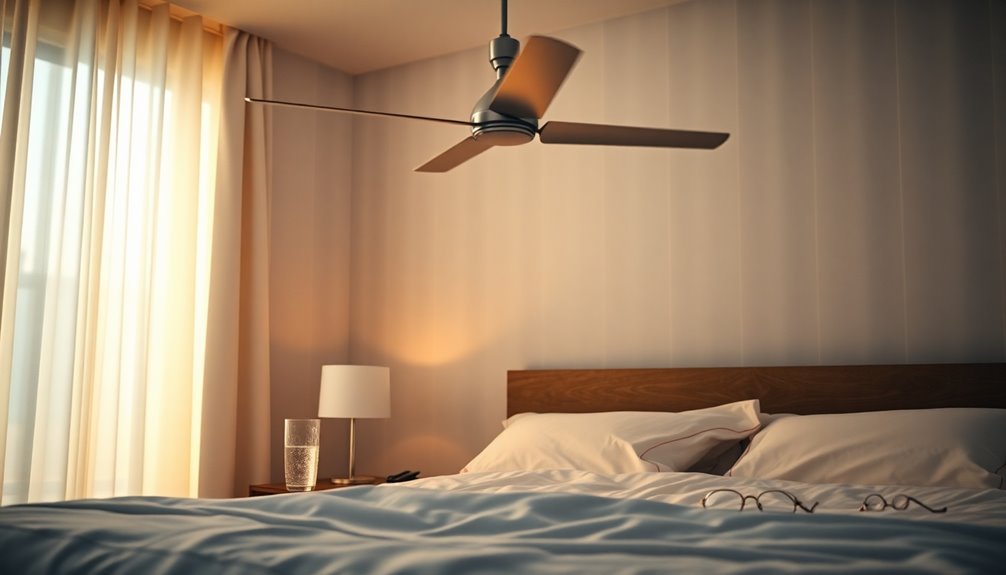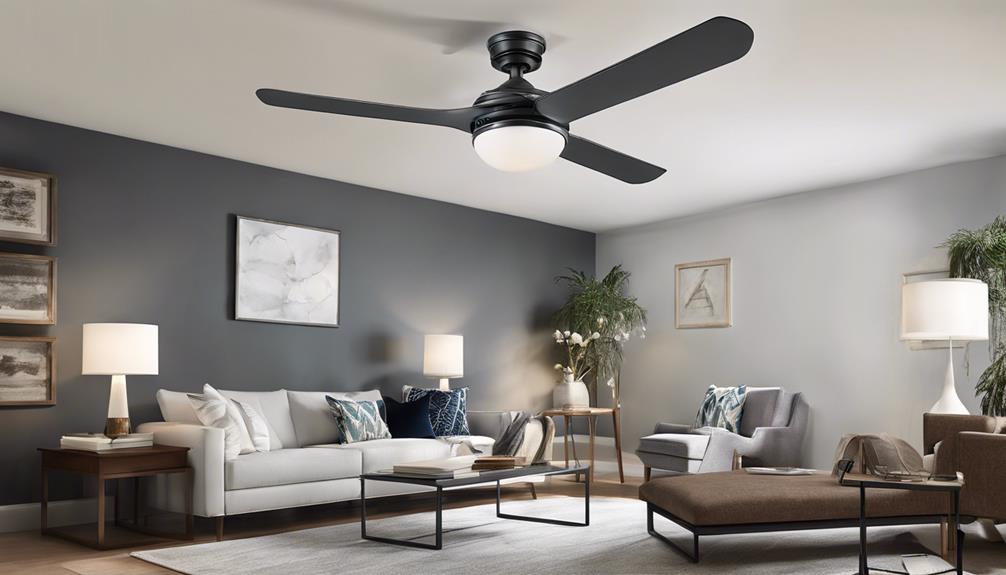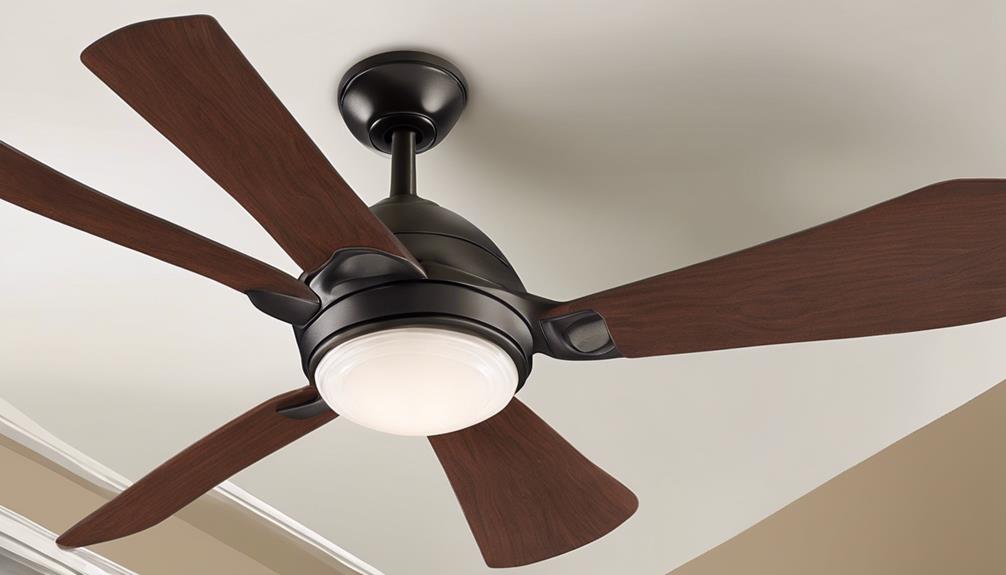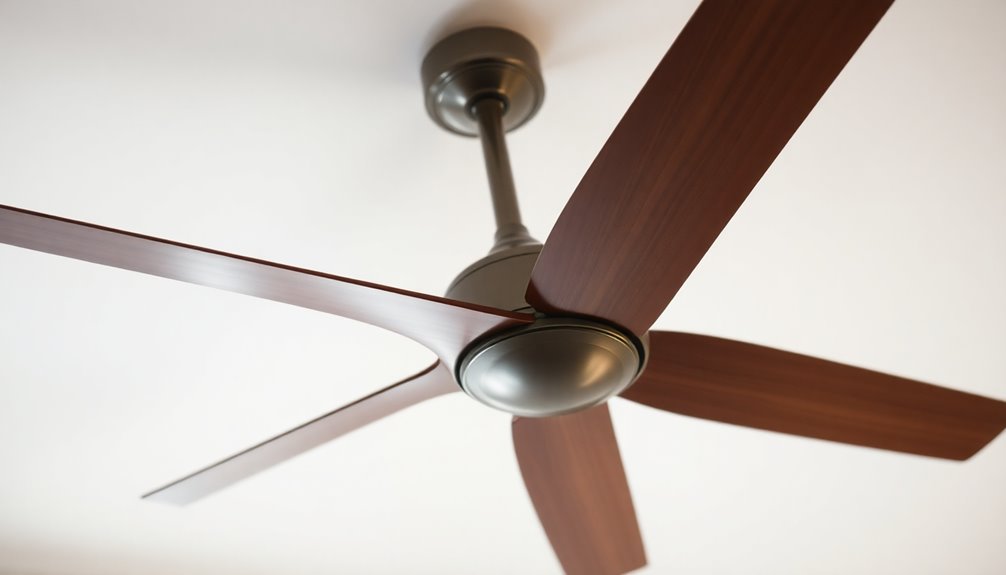Yes, ceiling fans help circulate air conditioning effectively. They improve airflow, ensuring cool air from your AC spreads evenly throughout the room, eliminating hot and cold spots. This allows you to raise your thermostat setting by 2-4°F while staying comfortable, saving you 20-30% on energy costs. Additionally, ceiling fans use much less energy than AC units, reducing the workload on your cooling system and extending its lifespan. For optimum results, adjust your fan's direction seasonally and maintain it properly. Discover strategies to maximize your cooling efficiency and comfort even further.
Key Takeaways
- Ceiling fans improve airflow, circulating cool air from the AC for even temperature distribution and reducing hot and cold spots.
- They enhance the cooling effectiveness of air conditioning by eliminating temperature inconsistencies throughout the room.
- Using ceiling fans allows you to raise thermostat settings by 2-4°F while maintaining comfort, leading to energy savings.
- Ceiling fans consume significantly less power than AC units, reducing overall energy bills and extending the lifespan of cooling systems.
- The wind chill effect created by ceiling fans provides a cooling sensation, allowing for a more comfortable indoor environment.
Benefits of Ceiling Fans

Ceiling fans offer several significant benefits that can enhance your comfort and energy efficiency at home.
First and foremost, ceiling fans help circulate the cool air produced by your air conditioning unit, ensuring it reaches every corner of the room. This improved airflow creates a more comfortable environment, allowing you to enjoy a consistent temperature without hot spots. Additionally, the use of ceiling fans can encourage mindful consumption of energy resources, promoting a more sustainable lifestyle. Moreover, utilizing ceiling fans can foster a culture of continuous learning about energy efficiency practices, enhancing overall awareness in the household. In addition, they work effectively in conjunction with heat pumps, optimizing temperature regulation throughout the space.
By utilizing the wind chill effect, ceiling fans make you feel cooler than the actual room temperature. This means you can raise your thermostat setting by 2-4 degrees while still feeling comfortable, which directly contributes to energy savings. Additionally, this practice aligns with the concept of energy-efficient models, which can significantly lower electricity costs.
In fact, using ceiling fans alongside your air conditioning can lead to energy savings of 20-30%, reducing the strain on your AC system. This synergy is similar to how commercial grade heat pumps operate efficiently by maintaining consistent indoor temperatures and reducing overall energy costs.
When you position and size your ceiling fans correctly, they become a valuable ally in maintaining a pleasant atmosphere.
Not only do they enhance your overall comfort, but they also help lower your energy bills. Embracing ceiling fans in your home can effortlessly create an environment that's both enjoyable and cost-effective.
How Ceiling Fans Work

Ceiling fans work by creating a breeze that enhances the wind chill effect, making you feel cooler even when the room temperature stays the same.
By circulating air effectively, they help eliminate hot and cold spots, ensuring a more comfortable environment. Understanding how airflow enhancement works will help you maximize the benefits of your ceiling fan alongside air conditioning. Additionally, modern Energy Star certified fans can raise the thermostat temp by 4°F, allowing for increased energy savings while maintaining comfort.
Airflow Enhancement Mechanism
One of the most effective ways to enhance airflow in a room is through the use of ceiling fans, which create a revitalizing breeze that helps distribute cool air evenly.
By circulating air effectively, ceiling fans work to lower temperatures without altering actual air conditioning settings. Here's how they do it:
- Breeze Creation: Ceiling fans generate a gentle breeze that allows you to feel cooler, enhancing comfort levels.
- Counterclockwise Rotation: During summer, fans should rotate counterclockwise to maximize airflow and promote a wind chill effect.
- Thermostat Adjustment: You can raise your thermostat settings by up to 4°F without discomfort, thanks to the cooling sensation created by the fan.
- Energy Savings: By reducing the workload on your air conditioning system, ceiling fans can save energy, potentially lowering your energy consumption by 20-30%.
Properly positioned and sized ceiling fans help eliminate hot and cold spots in the room, creating a more consistent temperature throughout.
Wind Chill Effect
By circulating air effectively, ceiling fans create a wind chill effect that enhances your comfort level without actually lowering the room temperature. This phenomenon occurs because the moving air helps evaporate moisture from your skin, making you feel cooler. In summer, when ceiling fans rotate counterclockwise, they produce a downward draft, helping distribute the cool air from your air conditioning more evenly throughout the room.
You can even raise your thermostat settings by 2-4°F comfortably, thanks to this wind chill effect, which can make a room feel up to 5°F cooler. This adjustment not only maintains your comfort but also boosts energy efficiency by reducing the workload on your AC unit. Let's look at some key benefits:
| Benefit | Description | Outcome |
|---|---|---|
| Enhanced Comfort | Increases perceived coolness without lowering temp. | Improved comfort level |
| Energy Savings | Reduces AC workload by raising thermostat settings. | Lower energy bills |
| Consistent Temperature | Minimizes hot and cold spots in the room. | Uniform comfort |
| Extended AC Lifespan | Decreases strain on the air conditioning unit. | Longer lifespan |
Incorporating ceiling fans with your air conditioning system is a smart choice!
Optimal Fan Usage

Effective air circulation is key to maximizing comfort and efficiency in your home. To achieve ideal fan usage, follow these simple guidelines:
- Set your fan to rotate counterclockwise during summer. This creates a cooling downdraft that helps enhance air conditioning efficiency.
- Choose the right size fan. For rooms up to 225 sq ft, fans between 36-44 inches work better to circulate conditioned air effectively.
- Use ceiling fans only in occupied rooms. Turning them off when the room is empty can save on energy since fans cool people, not the air.
- Keep fan blades clean and unobstructed. This maintenance step considerably boosts airflow and guarantees your air conditioning system performs at its best.
Energy Efficiency Insights

Maximizing energy efficiency in your home can be as simple as incorporating ceiling fans into your cooling strategy. These fans consume about 70 watts of energy, considerably less than air conditioners, which can exceed 2000 watts.
By adding a ceiling fan, you can reduce your air conditioning usage by 20-30%, leading to substantial savings on your energy bills. Additionally, energy-efficient models of heat pumps can significantly enhance your overall savings.
Using Energy Star-rated ceiling fans can further enhance efficiency and lower operational costs, adding to your overall energy savings.
With a ceiling fan, you can raise your thermostat settings by up to 4°F while still feeling comfortable. This adjustment optimizes energy use in conjunction with your air conditioner.
Additionally, the increased air circulation from ceiling fans not only cools your space more effectively but also reduces the workload on your air conditioning system.
This decreased strain can potentially prolong the lifespan of your air conditioner, saving you money in the long run. Furthermore, regular maintenance of heat pumps can enhance overall system efficiency and performance, further contributing to your energy savings.
Impact on Air Conditioning

Using ceiling fans alongside your air conditioning can greatly improve airflow distribution, making your space feel cooler and more comfortable.
You'll notice enhanced temperature consistency throughout the room, eliminating those annoying hot and cold spots.
Plus, this combination reduces the cooling load on your AC, which can lead to energy savings and a longer lifespan for your unit.
Improved Airflow Distribution
Ceiling fans play an essential role in improving airflow distribution, greatly enhancing the performance of air conditioning systems. By creating a wind chill effect, ceiling fans help circulate the cool air produced by your AC, making your indoor environment more comfortable.
Here's how they work:
- Cooler Air Circulation: Ceiling fans push down cool air, ensuring it reaches every corner of the room.
- Thermostat Flexibility: You can raise your thermostat settings by 2-4°F without losing comfort, lowering energy costs.
- Humidity Control: Properly positioned ceiling fans help dehumidify the air, removing excess moisture and increasing comfort levels.
- Energy Savings: Using ceiling fans with your air conditioning can lead to energy savings of 20-30%, making your cooling system more efficient.
With improved airflow distribution from ceiling fans, you not only enhance your comfort but also increase the efficiency of your air conditioning.
This synergy allows you to enjoy a cooler environment while benefiting your wallet through savings.
Enhanced Temperature Consistency
Maintaining a consistent temperature in a room can be a challenge, especially with air conditioning systems that may struggle to evenly cool a space.
Ceiling fans play an essential role in enhancing temperature consistency by promoting even air circulation. This reduces those pesky hot and cold spots that can make your living environment uncomfortable.
When you use ceiling fans alongside your air conditioning, you'll notice improved comfort levels. The enhanced airflow allows cooled air from your AC unit to be distributed more evenly, making it easier to maintain a steady temperature throughout the room.
In fact, you can raise your thermostat settings by 2-4 degrees Fahrenheit without sacrificing comfort, leading to significant energy savings.
Moreover, the wind chill effect created by ceiling fans contributes to a perceived temperature drop, effectively increasing the efficiency of your air conditioning system.
This not only keeps you comfortable but also helps dehumidify the air, further enhancing your indoor environment.
Reduced Cooling Load
Integrating ceiling fans into your cooling strategy can considerably reduce the cooling load on your air conditioning system. By improving air circulation, you can enjoy a more comfortable environment while also lowering your AC's energy consumption.
Here's how you can benefit:
- Set Your Thermostat Higher: You can increase your thermostat setting by 2-4°F without feeling uncomfortable, thanks to the wind chill effect created by ceiling fans rotating counterclockwise in summer.
- Enhance Air Distribution: Ceiling fans help distribute cool air evenly, minimizing hot spots and creating a more consistent temperature throughout the room.
- Lower Energy Bills: Using ceiling fans can decrease your energy consumption by 20-30%. With ceiling fans operating at around 70 watts compared to 2000+ watts for your AC system, the savings add up.
- Prolong Your AC's Lifespan: By reducing the workload on your AC, ceiling fans can help extend its lifespan, ensuring you get more years out of your investment.
Incorporating ceiling fans into your cooling system is a smart move to reduce the cooling load while keeping your space comfortable and energy-efficient.
Seasonal Fan Direction

When summer arrives, you'll want to set your ceiling fan to rotate counterclockwise. This seasonal fan direction creates a cooling downdraft, enhancing your air conditioning's effectiveness and helping to cool your home more efficiently.
By using ceiling fans this way, you can feel cooler without cranking down the thermostat, which can save you money on energy bills.
In winter, switch your fan to rotate clockwise. This action pushes warm air that rises to the ceiling back down into your living space, ensuring a comfortable atmosphere.
Adjusting the fan direction according to the season can allow you to raise the thermostat setting by 2-4°F without sacrificing comfort.
The fan direction switch is usually located on the fan's base, making it easy to change as the seasons shift.
Using ceiling fans correctly not only keeps you comfortable but also boosts energy efficiency.
By aligning your fan's rotation with the seasonal needs of your home, you can reduce reliance on heating and cooling systems, ultimately lowering your energy consumption and costs.
Maintenance Tips for Fans

Ceiling fans play an essential role in keeping your home comfortable, but they require regular maintenance to operate at their best. By following these simple tips, you can guarantee your fan works efficiently and effectively:
- Regularly clean the fan blades and fixtures to prevent dust buildup, which can hinder airflow and reduce efficiency.
- Inspect and tighten any loose screws or components. This eliminates noise and wobbling, guaranteeing smooth operation for better air circulation.
- Check fan blades for warping or damage. Compromised blades affect performance, so repair or replace them according to the manufacturer's guidelines.
- Lubricate older ceiling fans as needed, following the owner's manual, to maintain ideal motor function and prevent wear and tear.
Additionally, always monitor for any unusual sounds**** or slow rotations. Addressing these issues promptly will help your fan continue to circulate air effectively.
Regular maintenance not only prolongs the life of your ceiling fan but also enhances its performance, providing you with a more comfortable living environment.
Keep these tips in mind, and your ceiling fan will serve you well for years to come.
Cost Savings With Ceiling Fans

Using ceiling fans can lead to significant cost savings on your energy bills. When you use ceiling fans alongside your air conditioning system, you can save about 12% on cooling costs. By allowing you to raise your thermostat settings by up to 4°F while still feeling comfortable, ceiling fans help reduce your reliance on air conditioning.
Operating at around 70 watts, ceiling fans consume far less energy compared to air conditioning units, which can use over 2000 watts. This efficiency translates to reduced air conditioning usage by 20-30% in occupied rooms, leading to lower energy bills.
Imagine how much you could save by simply using fans more effectively!
If more households across the U.S. embraced ceiling fans, the potential energy savings could reach billions annually. Not only would this benefit your wallet, but it would also be good for the environment.
Frequently Asked Questions
Should You Use a Ceiling Fan With Air Conditioning?
Using a ceiling fan with air conditioning is a smart choice.
It helps distribute cool air evenly, making your space feel more comfortable. You can even raise your thermostat settings by a few degrees without losing comfort.
Plus, ceiling fans are much cheaper to run, so you'll save on energy costs.
Do Ceiling Fans Improve AC Efficiency?
Using a ceiling fan is like adding a gentle breeze on a hot day—it enhances your comfort.
Yes, ceiling fans improve AC efficiency by promoting better air circulation throughout your space.
When you run your fan counterclockwise in the summer, it helps distribute cool air evenly, making the room feel cooler.
This allows you to set your thermostat higher without sacrificing comfort, ultimately reducing energy costs and extending your AC unit's lifespan.
Will a Fan Help an AC Cool a Room?
Yes, a fan can definitely help cool a room.
When you use a fan, it creates airflow that enhances the cooling effect, making you feel cooler even if the actual temperature doesn't drop.
You can set the fan to rotate counterclockwise in summer for an ideal breeze.
This way, you'll stay comfortable while using less energy, allowing your air conditioning to work more efficiently and even potentially saving you money on cooling costs.
How Do You Circulate Cool Air With a Ceiling Fan?
Imagine stepping into a room, feeling the heat cling to your skin. You can change that!
To circulate cool air with a ceiling fan, set it to spin counterclockwise during the summer months. This creates an invigorating downward draft, enhancing your comfort.
Position the fan strategically to avoid obstacles, and pair it with your air conditioner. You'll notice a difference as the cool air spreads evenly, turning that sweltering room into a cozy haven.
Conclusion
Incorporating a ceiling fan into your cooling strategy is like adding a dash of seasoning to your favorite dish—it enhances the experience without overwhelming it. By circulating cool air from your air conditioning, ceiling fans make your space feel more comfortable while saving you money on energy bills. So, next time you crank up the AC, remember to turn on that fan. Together, they create a revitalizing breeze that dances through your home, making every day feel like a summer getaway.









